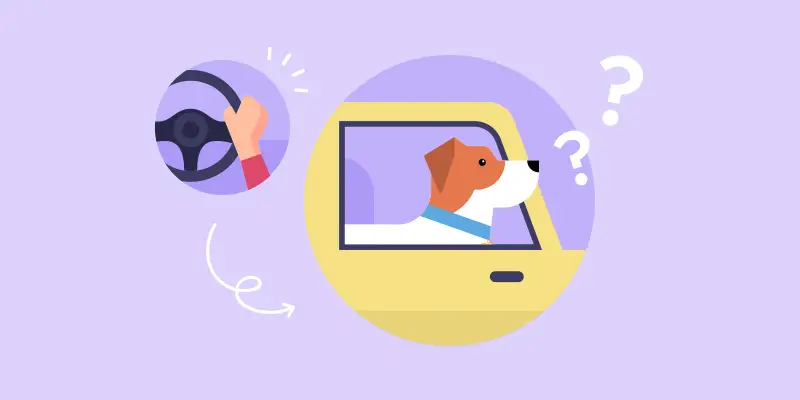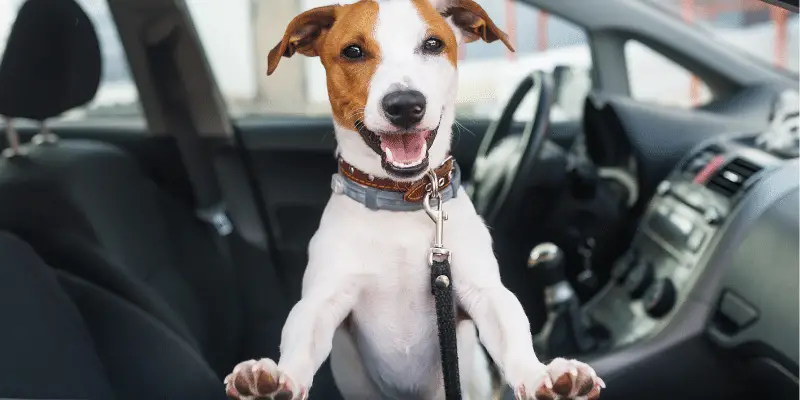How to travel safely with a puppy in the car
- Written by Joshua Gordon
- Last updated
In this article

Car travel is really important and an everyday occurrence for many dog owners in the UK. Although perfectly legal to travel with a pet, unrestrained dogs can be a distraction whilst driving in the car.
We take a look at the UK Government guidance on pet travel and what you can do to keep both you and your passenger safe.
Let’s take a look…
What are the UK Laws on Dogs Traveling in Cars?
In the UK it is legal to travel with your pet in the car. The UK Highway Code’s Rule 57 outlines that when in a vehicle make sure your “dogs or other animals are suitably restrained so they cannot distract you while you are driving or injure you”. To do this they suggest “A seat belt harness, pet carrier, dog cage or dog guard are ways of restraining animals in cars.”
Is it Illegal to Have a Dog in the Car Unrestrained?
It should be noted that legislation has not made it an actual legal requirement so it does not carry a direct penalty if you break the code. However, a law enforcement officer could cite you with “driving without due care and attention” which would place anywhere from three to nine points on your driver’s license.
In addition, if an accident occurs then it could be used as evidence to show you were at fault because the pet may have contributed to the occurrence. In such an instance, your pet and car insurance would be rendered invalid and you could face a fine of up to £5,000 from the court and sustain points on your license.

Ask the Vet - How should my puppy ride in the car?
"The safest way to transport your pup in the car is either in a crate or harness. When very young or small, a harness may not fit well, so a crate usually works best. Travelling without your dog strapped in is a hazard and could result in them getting injured or, if you get distracted by them bouncing about, could cause a crash"
- Dr Linda Simon MVB MRCVS

How to Properly Travel with Dogs
As your dog’s owner, it’s your responsibility to ensure the animal’s safety while taking a car trip. You not only have a legal obligation but a moral one. Dogs should always be secured in the rear passenger area of the car’s interior.
There are a number of ways to secure your pet in the car;
Pet guards
Pet owners can use a guard that is positioned between the passenger seats and the boot. The guard is fashioned from mesh or metal and helps prevent the dog from moving into the front of the car in the event of an accident. This option does not stop the pet moving in the event of sudden braking or an accident and could cause injury to the dog. There is the option to use either a crate, carrier or harness/seat belt for further protection.
Crates and carriers
A crate or carrier placed in the boot of the car provides a safe area for your dog while traveling. You can secure the carrier in the rear passenger seat using the seat belt. If the crate fits, it can also be placed in the footwells of the vehicle.
However, never place the crate in the front passenger seat due to the potential danger created by the airbag if an accident should occur.
Ideally, the crate should allow the dog to turn, lie down and stand. Pick a strong enclosure that has handles or grips so you can easily move it. Place an absorbent material on the leak-proof bottom of the crate in case your pet has an accident.
Always label the crate that lists the following;
- Owner’s name
- Pet’s name
- Owners address
- Phone number
- Emergency contact in the event of an accident.
We recommend placing one of your dog’s favourite toys in the carrier and attaching a water bottle to the side so the animal has access to fresh water on the road trip.
Take a look at our review of the best dog car crates you can get for your dog.
Harnesses and Belts
Some dogs are just too big to fit in a crate in the rear of your car. In such cases, you’ll need to secure the animal using a harness or canine seat belt.
The devices typically clip directly on your car’s seat belt fixture. The restraint usually runs across the dog’s upper torso to protect them in the event of an accident. When using a harness or belt, always make sure there is enough slack so your pet can move and find a comfortable travelling position.
Never use a harness or belt in the front passenger seat. Also, make sure that the window is not rolled down too far. A slight crack is okay but you don’t want your dog to poke his head out of the window and potentially fall or jump through the opening while being hooked to the harness or belt.
Tips for Travelling with Dogs
Here’s some top tips to make your dog’s experience is as pleasant as possible during a car journey;
- Drive carefully by avoiding rapid acceleration or hard braking if possible which can jostle or throw the pet around.
- Pack a favourite blanket or toy to help your dog relax during the journey.
- Provide fresh water using a water bottle or travel bowl designed not to spill. Some pets also enjoy food but others can become car sick so you’ll need to gauge how well your dog travels to determine if you should provide food.
- If driving long distances, make frequent stops so your pet can stretch and go to the toilet to avoid unwanted accidents in the car.
- Attach proper identification to your dog’s collar in case of an accident.
- Pack a doggy first aid kit with bandages, scissors, tweezers, antibiotic ointment, and other necessities in case of an injury or unforeseen illness.
- Carry your dog’s medical records such as proof of vaccinations and licensing.
- Never leave your pet alone in a car on a hot or extremely cold day.
- Make sure that your pet can see out the window if he suffers from car sickness. You can also request a prescription from your veterinarian for medication to relieve motion sickness in pets that suffer.
- Even though some dogs enjoy sticking their head out the window you should roll the window up for safety. Gravel and other road debris can easily be kicked up by the car’s tires and cause injury to your dog.

